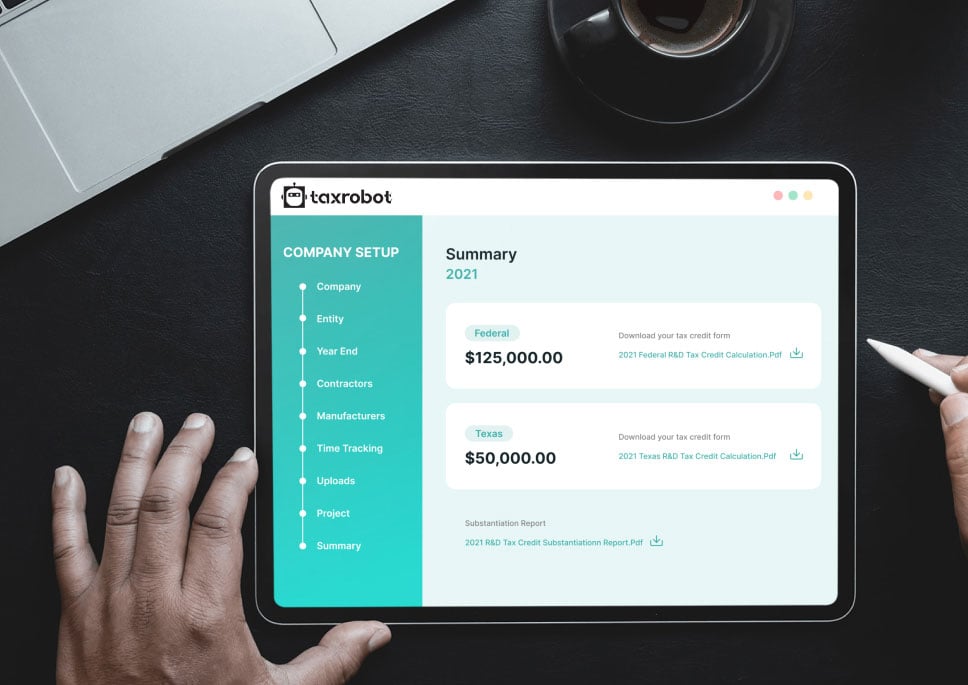Montana R&D Tax Credit
With TaxRobot, Montana R&D Tax Credit becomes more than a benefit—it becomes a catalyst for your business growth. Unleashing the incredible, simplifying the complex. This is not just tax planning; it’s financial evolution.
Maximize your State Credits today!
Put the R&D tax credit process on autopilot.
Trusted By:








Montana R&D Tax Credit
Discover your eligibility for Montana R&D tax credits and supercharge your enterprise.
Montana R&D Tax Credit: A Comprehensive Guide with TaxRobot
Welcome to TaxRobot, your trusted partner in navigating the complexities of R&D tax credits in Montana. While the state doesn’t offer a specific R&D tax credit, we’re here to unlock the potential of the Federal R&D Tax Credit for businesses in Montana.
With our AI-powered software and expertise, we simplify the process, ensuring you maximize your tax refunds without any hassle.
Let TaxRobot handle the intricacies while you focus on what you do best – running your business and driving innovation.
Understanding the Montana R&D Tax Credit
While Montana doesn’t currently provide a state-level R&D tax credit, don’t worry because there’s still good news for businesses in the Treasure State. You may be eligible to claim the Federal R&D Tax Credit, a valuable opportunity to offset your research and development expenses.
The Federal R&D Tax Credit has been in effect since 1981. It offers substantial financial benefits to companies engaged in qualifying research activities.
At TaxRobot, we understand the nuances of the Montana tax landscape, and we’re here to guide you through the process, ensuring you take full advantage of the Federal R&D Tax Credit and maximize your potential benefits.
The TaxRobot Advantage
When simplifying the R&D tax credit process and maximizing your refunds, TaxRobot is the trusted choice. Our AI-powered R&D Tax Software offers an easy-to-use platform that streamlines the entire process, ensuring you save time and effort.
With TaxRobot, you gain access to our team of subject matter experts who have delivered millions of dollars in tax credits to clients nationwide.
We pride ourselves on delivering bigger refunds than other consultants and software products, with some clients seeing up to 3X the tax credit amount.
Experience the TaxRobot advantage and leave the complexities to us while you focus on growing your business.
Simplified R&D Tax Credit Process
At TaxRobot, we believe in making the R&D tax credit process as simple as possible. With our three-step approach, claiming your tax credit becomes a breeze.
- Please provide us with the necessary information about your research activities.
- We seamlessly link with your systems to gather the required data.
- Please sit back and relax as we handle the rest, ensuring you receive your refund promptly.
Our algorithms save you valuable time, allowing you to focus on running your business. At the same time, we maximize your R&D tax credit.
Superior Documentation and Audit Support
When it comes to R&D tax credits, documentation is crucial. With TaxRobot, you can rest easy knowing that our software provides superior documentation that satisfies statutory and IRS reporting requirements.
We understand the importance of maintaining audit-proof paperwork. In the unlikely event of an audit, our dedicated team supports you every step of the way. We handle any questions or requests that may arise, ensuring a smooth process and giving you peace of mind.
Value-Based Pricing and Bigger Refunds
At TaxRobot, we believe in providing exceptional value to our clients. That’s why we offer value-based pricing, ensuring you only pay a fee if you receive a tax credit.
We aim to deliver bigger refunds compared to competing consultants and software products. Our expertise and advanced algorithms have helped clients achieve remarkable results, with some seeing up to 3X the amount of tax credit.
Experience the difference of TaxRobot, where value and maximizing your refunds are our top priorities.
Simplify Your R&D Tax Credit Process with TaxRobot in Montana
When it comes to navigating the complexities of R&D tax credits in Montana, TaxRobot is your trusted partner. Our AI-powered software, combined with our expertise, simplifies the process, ensuring you maximize your tax refunds without the hassle.
With our value-based pricing, superior documentation, and audit support, we go the extra mile to deliver exceptional results for your business.
Don’t let the lack of state-level credit deter you. Explore the potential of the Federal R&D Tax Credit with TaxRobot and unlock the benefits for your innovation-driven company today.
Take a sneak peak

- Limited Time Offer
- Simple Onboarding
- Easy to Use
R&D Tax Credits FAQs
The four-part test as outlined in the Internal Revenue Code is used to determine qualified R&D activity.
The Four-Part Test
1). New Or Improved Business Component
Creation of a new product, process, formula, invention, software, or technique; or improving the performance, functionality, quality, or reliability of existing business component.
- Construction of new buildings or renovation of existing buildings
- Invention of a software application
- Manufacturing of a new product or the improvement of the production process for an existing product
- Creation of design documentation
2). Technological In Nature
The activity fundamentally relies on principles of the physical or biological sciences, engineering, or computer science. A taxpayer does not need to obtain information that exceeds, expands or refines the common knowledge of skilled professionals in a particular field.
- Physics (relationship between mass, density and volume; loading as the
result of gravitational attraction) - Engineering (mechanical, electrical, civil, chemical)
- Computer science (theory of computation and design of computational systems)
3). Elimination Of Uncertainty
Uncertainty exists if the information available to the taxpayer does not establish the capability or method for developing or improving the business component, or the appropriate design of the business component.
- The capability of a manufacturer to create a part within the specified tolerances
- The appropriate method of overcoming unsuitable soil conditions during construction
- The appropriate software design to meet quality and volatility requirements
4). Process Of Experimentation
A process designed to evaluate one or more alternatives to achieve a result where the capability or method of achieving that result, or the appropriate design of that result, is uncertain as of the beginning of the taxpayer’s research activities.
- Systematic process of trial and error
- Evaluating alternative means and methods
- Computer modeling or simulation Prototyping Testing
The R&D tax credit is one of the most misunderstood tax incentives available. Considering the myriad of industries and activities that legally qualify for the credit, the term “research and development” is a misnomer. Additionally, the R&D tax credit requires specialized knowledge and technology to identify and calculate the incentive properly.
Companies of various industries are unaware that they are eligible to claim the R&D tax credit. Under the Internal Revenue Code’s definition of R&D, many common activities qualify. You can get tax benefits for industries including software, technology, architecture, engineering, construction, manufacturing, and more.
The R&D tax credit can be claimed for all open tax years. Generally, open tax years include the prior three tax years due to the statute of limitations period. In certain circumstances, the law allows businesses to claim the R&D tax credit for an extended period of time. It is common for companies to amend previous tax years to claim this benefit and reduce the maximum amount of tax liability.
Partnerships and S corporations must file this form to claim the credit. The credit will flow from the Form 6765, to the Schedule K-1, to the Form 3800 on the individual’s tax return. For individuals receiving this credit that have ownership interest in a partnership or S corporation, Form 6765 is not required on the individual return.
Individuals claiming this credit can report the credit directly on Form 3800, General Business Credit if their only source for the credit is a partnership, S corporation, estate, or trust. Otherwise, Form 6765 must be filed with the individual’s tax return (e.g. sole proprietorship).
For tax years prior to 2016, the credit can be used to reduce the taxpayer’s regular tax liability down to the tentative minimum tax. The credit cannot be used to offset alternative minimum tax. Beginning in tax year 2016, eligible small businesses have expanded utilization for the credit. For these eligible small businesses, the regular tax liability can offset alternative minimum tax using the “25/25” rule.
What our customers have to say
I highly recommend TaxRobot to anyone considering an R&D Tax Credit software to complete their analysis.

We decided to switch to TaxRobot… Best decision we’ve ever made. More affordable, and less complicated.

I couldn’t believe how easy it was! In under an hour, we saved enough money to hire a new employee.
